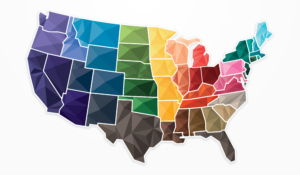
Have you ever gone to the store, bought something, looked at your receipt and said to yourself, “This item only cost $25, why did I pay $28 for it?” Well $3 was due to sales tax, which many people STILL fail to mentally figure in before going to the register. You may gasp and think to yourself, “Gosh, this amount is really high.” Well you were probably in a state that relies heavily on sales tax for revenue.
According to a study by the Tax Foundation in 2017, sales tax is the second largest source of state and local tax revenue behind property taxes .
Most states have a layered system of sales tax, which includes a state portion, a county portion, and then local sales taxes. Eight states administer a sales tax only at the state level, but not the local level: Connecticut, Indiana, Kentucky, Maine, Maryland, Massachusetts, Michigan and Rhode Island. And of the 50 United States, there are 5 which do not levy a state sales tax at all: the “NOMAD” states of New Hampshire, Oregon, Montana, Alaska and Delaware. Note that Alaska does allow local sales tax to be levied.
In this article, we explore various states and how their sales tax rates compare. We also take a look at which states are most dependent on sales tax revenue. As many states are beginning to take stock of the toll the Covid-19 pandemic is taking in terms of sheer dollar cost at the state and local levels, it’s an interesting time to consider where funding is going to come from.
High Reliance on Sales Tax
There does not seem to be a specific geographic region of the country that has focused on sales tax as their primary source of income. In addition, high sales taxes do not necessarily mean that other tax revenues are lowered as a result.
Washington, Louisiana, Nevada, and Tennessee rely most heavily on sales tax for revenue into their state.
In addition to its fairly high sales tax of 6.5% at the state level, plus many local taxes, which cause a combine rate to exceed 10%, Washington also has a property tax and an excise tax on gasoline, cigarettes and alcoholic beverages. Most foods are exempt from tax. However prepared foods, dietary supplements and soft drinks remain taxable.
In addition to a sales tax of minimum of 6.85%. Nevada also imposes a steep lodging tax, which makes sense given its destination (in Las Vegas, particularly) for conferences, concerts and other entertainment.
Louisiana has a lower state-based sales tax rate at 4.45%. However, the state also relies on severance taxes for revenue, which include oil, gas, timber and minerals.
Tennessee’s sales and use tax rate for most items is 7%, the 2nd highest state rate in the nation. Tennessee also allows local taxes, which means many areas charge a combined rate of over 9%. Food is taxed at a lower rate of 4%, but candy, dietary supplements and prepared food are taxed at 7%. While sales tax remains the main source of state government funding, property taxes are the primary source of revenue for local governments.
Low Reliance on Sales Tax
On the other hand, states like Vermont, Maryland, and Virginia are not very reliant on sales tax.
According to the Vermont department of revenue, the sales tax rate in the state is 6%. Additionally, the state also administers a meal and rooms tax, an alcoholic beverage tax and other miscellaneous taxes including a bank franchise tax and a solid waste tax.
Maryland’s rate is also 6%. To compensate for this lower sales tax rate, the state imposes a property tax on all real property in Maryland. Generally, properties that are owned and used by religious, charitable, or educational organizations or property owned by the federal, state, or local governments are exempt. Property taxes vary widely in Maryland. No restrictions or limitations on property taxes are imposed by the state, meaning cities and counties can set tax rates at the level they deem necessary to fund government services.
Virginia state sales and use tax rate is 4.3%, while the tax rate on food is 1.5%. There is an additional 1% local tax, for a total of 5.3%, combined sales tax on most Virginia purchases and 2.5% on most food. The sales tax rate is .7% higher in Northern VA and Newport News, where it is 6.0%. Virginia’s property tax is set and collected at the local government level and varies throughout the Commonwealth. Real estate is also taxed at the local level, based on 100% of the fair market value.
Other Sources of Income
Some states may make up a tax shortfall via an income tax. But what about states that do not levy an individual income tax? Texas is one of seven states that lacks an individual income tax; the other six are Alaska, Florida, Nevada, South Dakota, Washington and Wyoming. Instead Texas collects revenue from property taxes and sales tax. The state sales tax rate is 6.25%, but local taxing jurisdictions (cities, counties, special purpose districts, and transit authorities) may also impose sales and use tax up to 2% for a total maximum combined rate of 8.25%.
As mentioned above, Alaska is the only state that permits local sales taxes without imposing a state sales tax. Other local taxes levied include raw fish taxes, hotel, motel, severance taxes, liquor and tobacco taxes, gaming taxes, tire taxes and fuel transfer taxes.
According to the Alaska department of Revenue, the state depends primarily on income from petroleum and federal subsidies. These other taxes allow the state to have the lowest individual tax burden in the country.
Illinois has two rates for state sales tax: 6.25% for general merchandise and 1% for qualifying food, drugs, and medical appliances. Property tax is a major source of tax revenue for local and government taxing districts. The property tax is a local- not state- tax, imposed by local government taxing districts, which include counties, townships, municipalities, school districts, and special taxation districts. The property tax in Illinois is imposed only on real property.
The state sales tax rate in California is 7.25% which ranks 1st in the nation. California also generates a large portion of its revenue from its individual income tax, which the top rate is 13.3%
What to Think About In the Future
States have different ways of bringing revenue into their state. If a state has a lot of natural resources, like Alaska, they may have taxes surrounding those natural resources. States with a lower tax or with the omission of an income tax, often use property tax and other miscellaneous taxes as a way to bring in revenue.
In the last few months, states have struggled financially as a result of the Covid-19 pandemic. As states have rushed to acquire PPE, fund unemployment, and myriad other costs related to the pandemic, they are likely to find themselves in a significant shortfall unless they receive additional funding from the federal government. (In our home state of California, the governor recently predicted a shortfall of over $54 Billion, as a result of the coronavirus so far. As we imagine a post-Covid-19 world, where states look to make up significant budget shortfalls, we are expecting states and local governments to continue to rely on, and likely expand, sales tax to bridge those gaps. Expect to see rate increases and broadening of the tax base (likely to include more services) as state legislatures meet and struggle with how to raise additional funds.
If you have any questions about sales tax in states where you are doing business, it is helpful to consult with tax professionals, like Miles Consulting Group, to assist you. Stay tuned to our future blogs for updates on sales tax laws around the country. We are here to help with all of your multistate tax needs. Call us today!



















